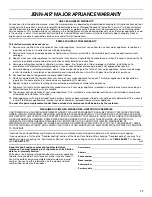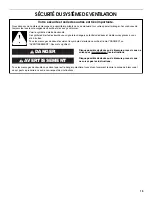
4
INSTALLATION REQUIREMENTS
Tools and Parts
Gather the required tools and parts before starting installation.
Read and follow the instructions provided with any tools listed
here.
Tools Needed
■
Jigsaw or keyhole saw
■
Drill
■
¹⁄₈
" (3 mm) drill bit for pilot holes
■
Pencil
■
Tape measure or ruler
■
Flat-blade screwdriver
■
Phillips screwdriver
■
³⁄₈
" (9.5 mm) nut driver
■
Level
■
Pliers
■
Metal snips
■
Wire stripper or utility knife
■
Caulking gun and weatherproof caulking compound
Parts Supplied
■
Top trim - stainless
■
End caps (2)
■
Lower support legs (2)
■
Undercounter mounting brackets (2)
■
4 x 8 mm screws (16)
■
3.5 x 9.5 mm screws (3)
■
3
¹⁄₄
" x 10" (8.3 x 25.4 cm) rectangular damper
■
4
³⁄₄
" (12.0 cm) motor box
■
¼" (6.4 mm) deep cover
■
Flat vent cover plate
■
6" (15.2 cm) diameter vent transition with damper
Parts Needed
■
UL listed or CSA approved ½" (12.7 mm) conduit connector
■
Wall or roof cap with damper to match vent system
■
Vent system
■
Home power supply cable
■
UL listed wire connectors (3)
■
Vent clamps/duct tape as required
Location Requirements
NOTE: Downdraft vent is installed directly behind the cooktop.
Install the downdraft vent first, then install the cooktop.
IMPORTANT: Observe all governing codes and ordinances.
■
Have a qualified technician install the downdraft vent. It is the
installer’s responsibility to comply with installation clearances
specified on the model/serial rating plate. The model/serial
rating plate is located on the front of the downdraft vent
above the terminal box cover.
■
Downdraft vent location should be away from strong draft
areas, such as windows, doors, and strong heating vents or
fans.
■
Cabinet opening dimensions that are shown must be used.
Given dimensions provide minimum clearance.
■
Consult the cooktop manufacturer installation instructions
before making any cutouts.
Check that the downdraft vent and cooktop location will
clear the cabinet walls, backsplash, and rear wall studs
inside the cabinet.
Check for the minimum distance between the front edge
of the countertop and the front edge of the cooktop. The
minimum horizontal distance between the overhead
cabinets is the same as the width of the installed
downdraft vent.
■
All openings in ceiling and wall where the downdraft vent will
be installed must be sealed.
■
Grounded electrical outlet is required. See “Electrical
Requirements” section.
■
When installing the downdraft vent, the cabinet drawer will
need to be removed and the drawer front installed
permanently to the cabinet.
Cabinet Construction:
Downdraft vent is designed for use in a cabinet with a depth of
24" (61 cm). Some installations require a countertop deeper than
25" (63.5 cm). See the “Countertop Cutout Dimensions Chart.”
The maximum depth of the overhead cabinet is 13" (33 cm).
Overhead cabinets installed at either side of the downdraft vent
must be 18" (45.7 cm) above the cooking surface.
For Mobile Home Installations
The installation of this downdraft vent must conform to
the Manufactured Home Construction Safety Standards,
Title 24 CFR, Part 328 (formerly the Federal Standard for
Mobile Home Construction and Safety, title 24, HUD, Part 280)
or when such standard is not applicable, the standard for
Manufactured Home Installation 1982 (Manufactured Home
Sites, Communities and Setups) ANSI A225.1/NFPA 501A, or
latest edition, or with local codes.
Summary of Contents for 30" RETRACTABLE DOWNDRAFT VENT SYSTEM
Page 18: ...18 Notes...




































